Keelboat recovery
Explore the best techniques to right an inverted keelboat
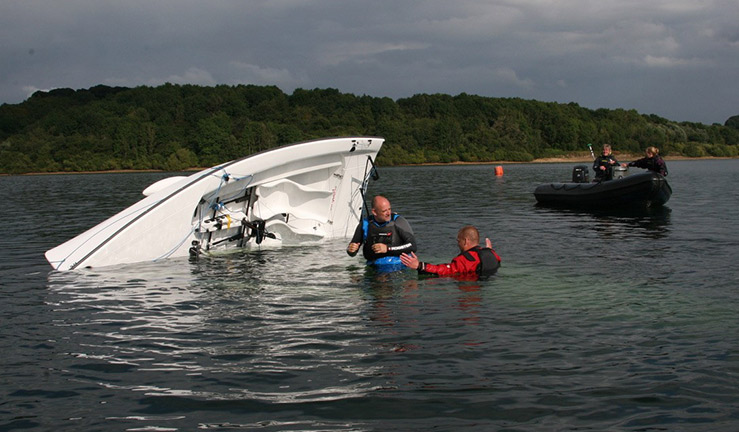
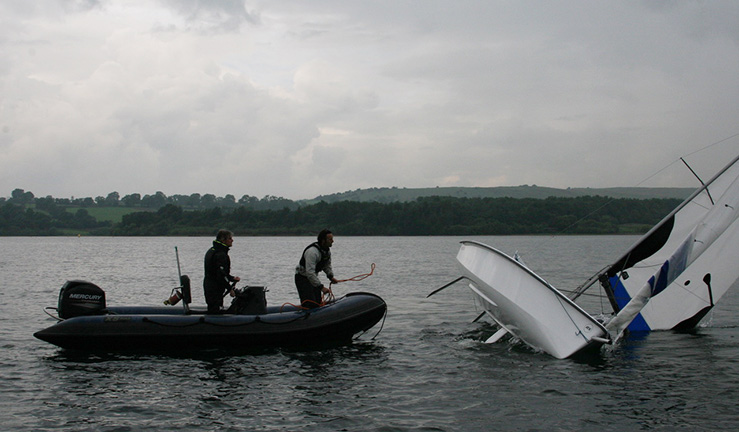
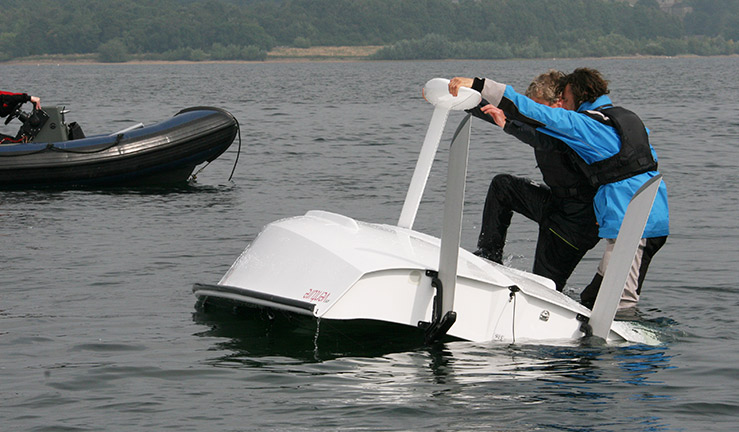
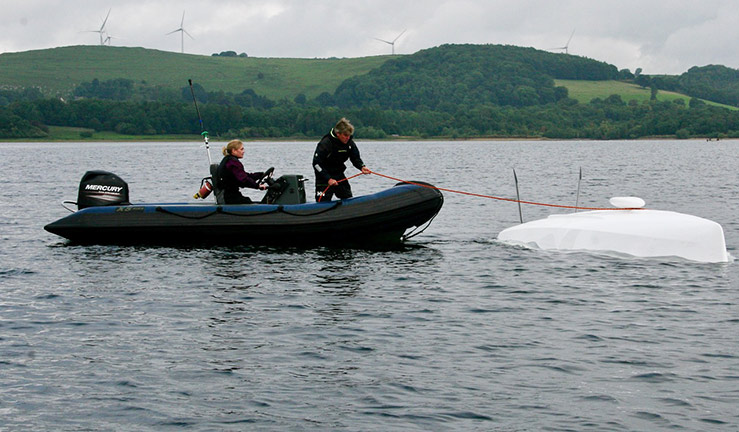
Keelboats can be a great way to spend time in the water, whether you are taking your first steps into sailing or want to race competitively.
Keelboats are often described as 'self righting' however self-righting means different things for different vessels.
- An all-weather lifeboat can recover from a full 180-degree inversion.
- With a fixed keel, self-righting may well mean that the vessel can recover from beyond the point where the mast is horizontal in the water.
- With a centre plate, self-righting can occur with no crew on board, with the centre plate down, and the mast at no more than 90 degrees.
Even self-righting boats can get ‘knocked down’ or capsize, when this happens there is a possibility of inversion and entrapment. If you are faced with such a situation, the important thing is knowing what to do and how to do it.
Two days learning at Carsington
We spent two days checking the best techniques to right an inverted keelboat

A team from across the RYA, trainers and safety boat drivers gathered at Carsington Water (an inland reservoir, with no significant current) to spend two days (the wind was light, variable and there were no significant waves) revisiting the best techniques to right an inverted keelboat, video the results and produce some useful resources for anyone involved in safety at clubs and centres up and down the country.
We took a RS Venture Connect, some rescue craft and some mast head floats; we set out across Carsington Water and inverted the boat numerous times, practicing the techniques that we thought would work.
- Engine size - exploring the impact of a 15hp, 50hp and 80hp engine
- Mast head floats - trying to right the vessel with no mast head float, 14.9Ltr, 24Ltr and finally 40Ltr at the top of the mast.
- Techniques and tow points - using the opposite shroud as a tow point, or the bulb at the end of the keel
- Keel position - righting the boat with the keel in the correct position for sailing and retracted
- Rib orientation - towing forwards and backwards
Thank you to RS Sailing and Carsington Sports and Leisure and Carsington Sailing Club for their support.
Always remember
1. Prevention
Avoid inversion by preventing it, by considering
- Mast head floats - every mast head float combination we used across the three days reduced the risk that the boat inverts in the first place, slowed the speed of inversion and bought us time, and made it much easier (more control, less power needed) and quicker (less time) to tow the boat upright.
- Use the boat as intended - follow the advice and guidance in the owner’s manual and other guides about how to rig and de-rig the boat, key safety features and the vessels limits (load, number of people, conditions for example)
- Familiarise yourself with the stability and righting characteristics of any boat you sail or are asked to recover
- Check the mechanisms for securing the keel are operating as intended and brief on the importance of their use every time
- Actively trim sails rather than cleating them off.
2. Preparation
makes it easier to use equipment under pressure, when you need it most.
3. Practice
Knowing what to do is one thing, knowing how to do it comes with practice and time on the water. The time it took us to right the boat got shorter as we practiced. We got used to how it felt, the nuances of where to point the engine as the tow came on and ensured our communication was clear and concise. Practice gets you familiar with the safety boats you use and the vessels they recover, in the conditions and environment you operate in.
The techniques
There are different techniques to safely right an inverted Keelboat in different situations
Knockdown
What happened
A capsize, with the mast parallel to the water, masthead float attached. The keel was extended and locked, with a 15Ltr mast head float at the top of the mast
The method we found worked the best
In all cases with the keel extended, and the mast horizontal to the water, the keelboat self-righted. No other outside assistance was required. (No keelboat crew in situ)
Things to be aware of
When the keelboat rights, ensure that at least one crewmember remains in contact with it, and climbs aboard as quickly as possible, as the keelboat may sail away unmanned.
Crew only
What happened
A capsize, subsequent inversion, with the crew (either from the safety boat or the keelboat) righting the boat without intervention from the safety boat itself.
The method we found worked the best

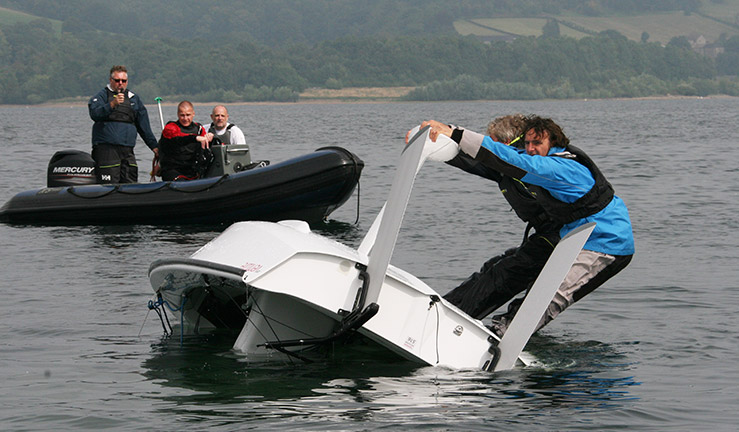
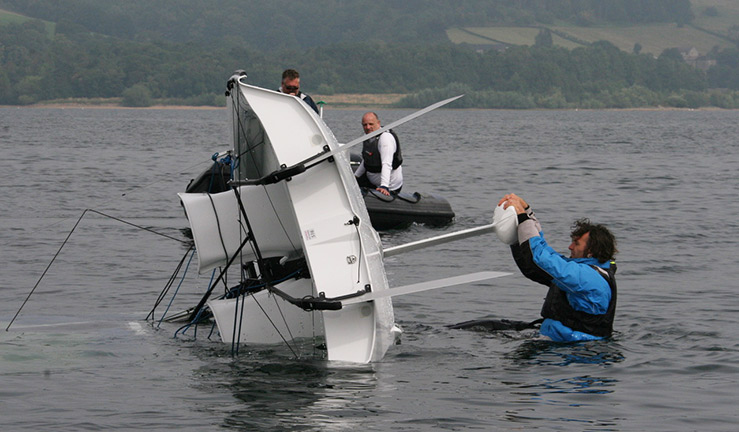

- Crew climbs onto upturned hull and grasps the keel-bulb firmly
- Crew applies their combined body weight to the keel, leaning back.
- The keelboat will begin to right
- As the keelboat reaches 90 degrees, the keelboat should then self-right
- If crew are quick/nimble enough, they should climb back into the keelboat as it fully rights. If not, they must be prepared to enter the water, remain in contact with the keelboat and be recovered in the usual, recognised manner
Things to be aware of
The owners manual suggests a combined crew weight of at least 150kg is needed. During the trials, it was found that if the masthead buoyancy was more than 15Ltrs, righting from inverted may be achieved with a single crew member.
Towline looped over keel bulb
What happened
Keelboat inverted. Safety boat tows the keelboat upright using a tow line looped over the keel, with both ends attached to a towing point on the safety boat.
The method we found worked best
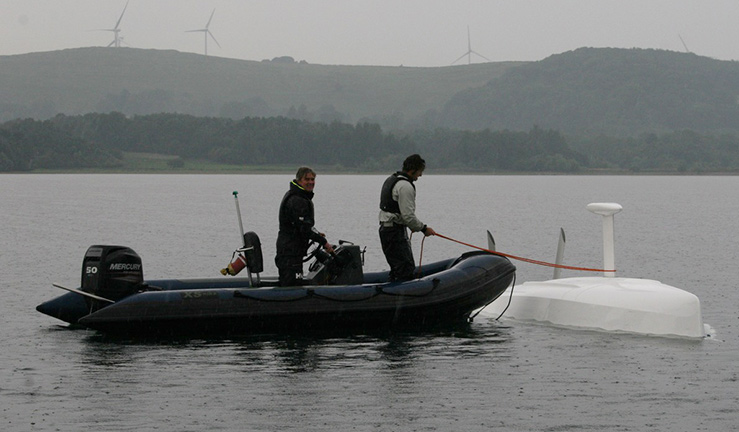
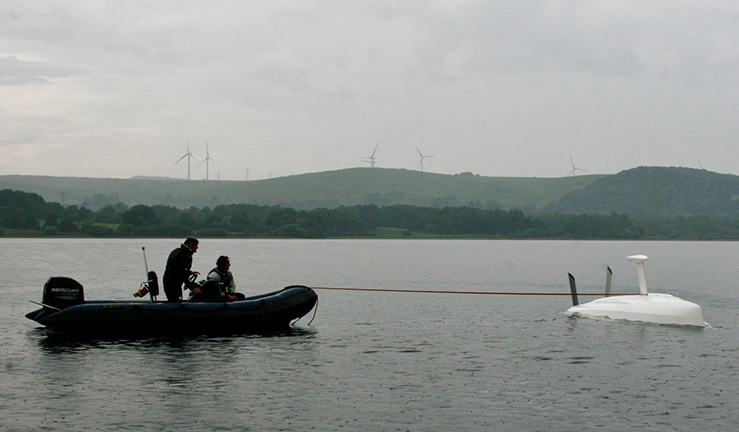
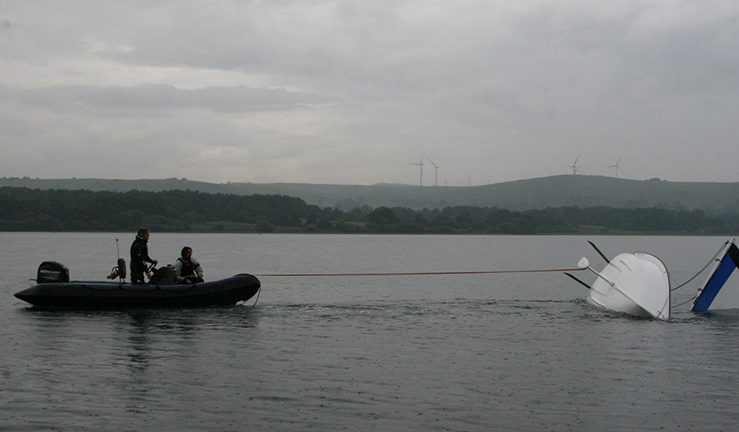

- The safety boat approaches the upturned hull. The standing end of the towline has already been secured to a strongpoint on/in the safety boat
- On arrival, the safety boat crew ‘loops’ the towline over the keel-bulb
- The safety boat reverses/drives away from the hull, as the crew pays out the towline
- The ‘working’ end of the towline is now made fast in the safety boat
- Once the towline is fully extended with no slack, helm applies sufficient power to begin righting the keelboat, manoeuvring to maintain a 90 deg attitude to the inverted hull
- As load is applied to the towline and the keelboat begins to right, the line will slide up the keel to the bulb, applying greater leverage
- As the keelboat reaches 90 deg, (mast parallel to the water), it will ‘self-right’
- Safety boat crew provides support to sailors
Things to be aware of
The method only works if the keel has a fixed bulb; the method worked with both a fully extended and retracted keel and with and without a mast head float (more power was needed and it took longer without a mast head float); you will need to ensure your two rope is long enough to double up; with practice this method can be quicker than towing from the opposite shroud
Towline to opposite shroud
What happened
Keelboat inverted. Safety boat tows the keelboat upright using a towline attached to the opposite shroud, passed across the upturned hull.
How to do the method
- The safety boat approaches the upturned hull. The standing end of the towline is already secured to a strongpoint on/in the safety boat
- On arrival, the safety boat crew climbs onto the upturned hull and secures the towline to the ‘furthest’ 'opposite' shroud.
- The safety boat reverses/drives away from the hull, as the crew pays out the towline
- Once the towline is fully extended with no slack, helm applies sufficient power to begin righting the keelboat, manoeuvring to maintaining a 90 deg attitude to the hull
- As the keelboat reaches 90 deg, it will ‘self-right’
- Safety boat crew provides support to sailors
Things to be aware of
The method worked with both a fully extended and retracted keel, and with and without a mast head float (more power was needed and it took longer without a mast head float); a carabiner at the end of the tow line can make it quicker to attach the tow rope to the shroud
Keel extended

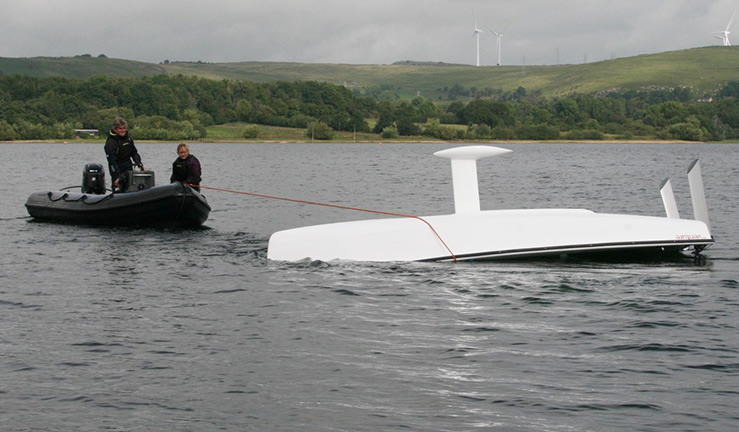
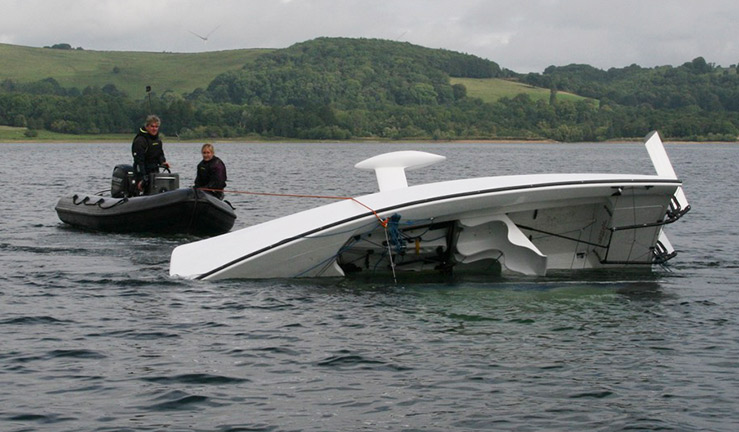
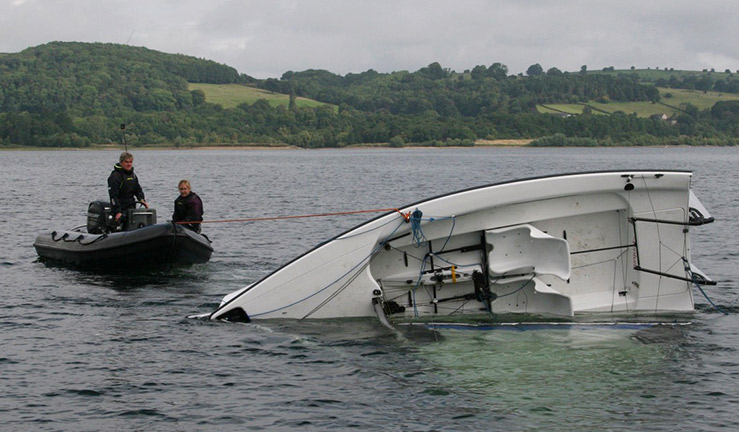
Keel retracted
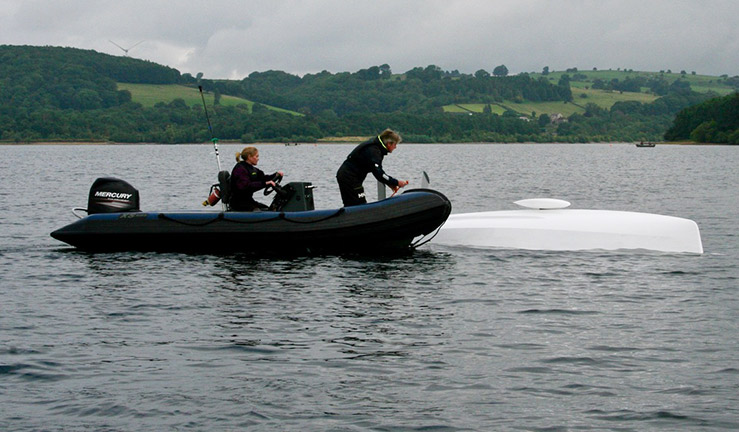

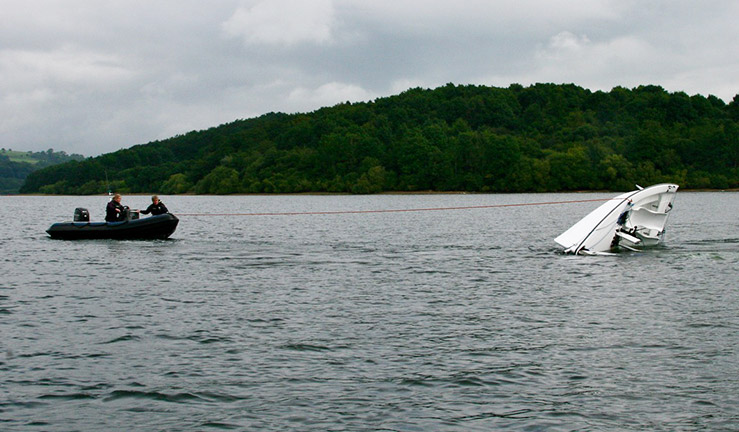
Important notes
- We did not have a crew on board the RS Venture either prior to or after the capsizes and so all righting techniques were conducted by the safety boat crew.
- The techniques shown below were only conducted on the RS Venture. While they are all established techniques known to work on other vessels, you should be prepared to carry out trials on any different keelboat in use at your own club or centre. Similarly the same principle applies to the safety boat type, size, engine power, and towline securing point.
- A 15 hp Jaffa was successful in recovering the upturned boat in every scenario, bar one. It wasn't able to right the boat with no mast head flotation when it was towing backwards (both keel retracted and extended), but it was successful with a longer tow rope, the Jaffa orientated forwards and towing from a bridle at the back of the boat.
Further reading
If you want to know more about keelboat safety and the methods we have demonstrated then you may find the following resources helpful
Mast head float blog
Guidance around safety practice where disabled people and those with long term health conditions are taking part
Keelboats within a training environment (access to Training Support required)
Independent operation of keelboats
